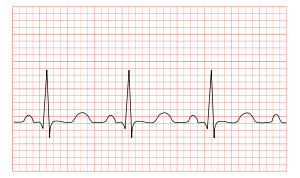Fast heart rate
| Tachycardia | |
|---|---|
 |
|
| ECG showing sinus tachycardia with a rate of about 100 beats per minute | |
| Pronunciation | Tachycardia /tækiˈkɑːrdiə/, tachyarrhythmia /tækiəˈrɪðmiə/ |
| Classification and external resources | |
| Specialty | Cardiology |
| ICD-10 | I47-I49, R00.0 |
| ICD-9-CM | 427, 785.0 |
| MeSH | D013610 |
Tachycardia, also called tachyarrhythmia, is a heart rate that exceeds the normal resting rate. In general, a resting heart rate over 100 beats per minute is accepted as tachycardia in adults. Heart rates above the resting rate may be normal (such as with exercise) or abnormal (such as with electrical problems within the heart).
The upper threshold of a normal human resting heart rate is based upon age. Tachycardia for different age groups is as listed below:
Heart rate is considered in the context of the prevailing clinical picture. For example: in sepsis >90 bpm is considered tachycardia.
When the heart beats excessively or rapidly, the heart pumps less efficiently and provides less blood flow to the rest of the body, including the heart itself. The increased heart rate also leads to increased work and oxygen demand by the heart, which can lead to rate related ischemia.
Relative tachycardia involves a greater increase in rate than would be expected in a given illness state.
Some causes of tachycardia include:
An electrocardiogram (ECG) is used to classify the type of tachycardia. They may be classified into narrow and wide complex based on the QRS complex. Presented order of most to least common, they are:
Tachycardias may be classified as either narrow complex tachycardias (supraventricular tachycardias) or wide complex tachycardias. Narrow and wide refer to the width of the QRS complex on the ECG. Narrow complex tachycardias tend to originate in the atria, while wide complex tachycardias tend to originate in the ventricles. Tachycardias can be further classified as either regular or irregular.
The body has several feedback mechanisms to maintain adequate blood flow and blood pressure. If blood pressure decreases, the heart beats faster in an attempt to raise it. This is called reflex tachycardia. This can happen in response to a decrease in blood volume (through dehydration or bleeding), or an unexpected change in blood flow. The most common cause of the latter is orthostatic hypotension (also called postural hypotension). Fever, hyperventilation, diarrhea and severe infections can also cause tachycardia, primarily due to increase in metabolic demands.
...
Wikipedia
